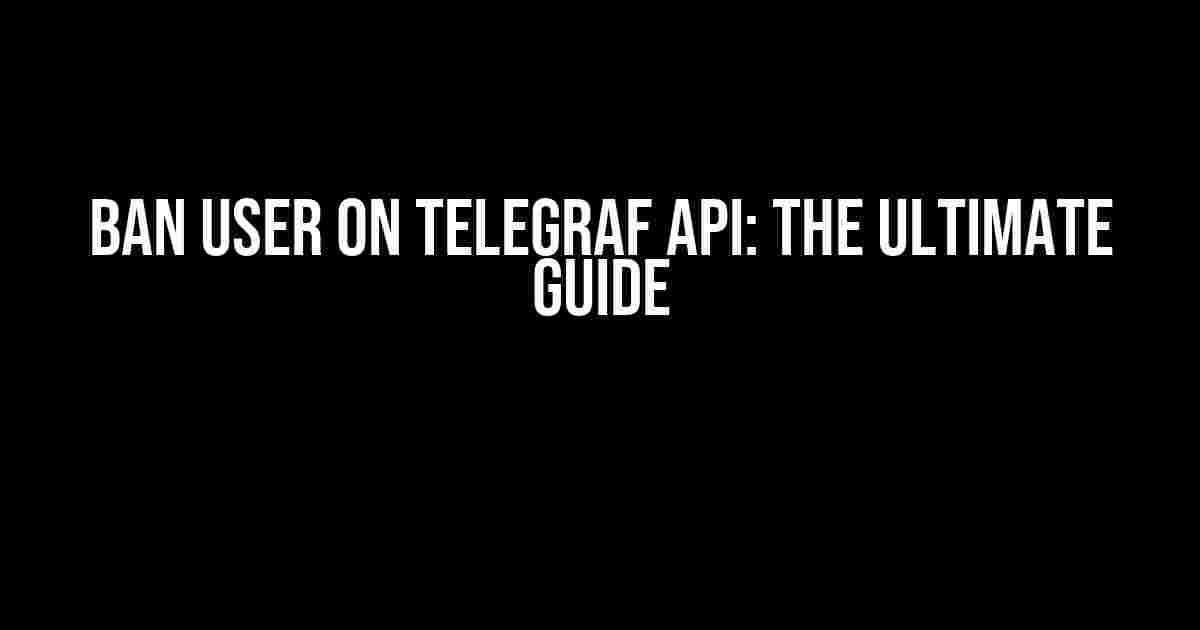Are you tired of dealing with unruly users on your Telegraf API platform? Do you want to maintain a secure and respectful community? Then you’re in the right place! In this comprehensive guide, we’ll show you how to ban a user on Telegraf API, step-by-step. From understanding the importance of user management to implementing the ban, we’ve got you covered.
- Why Ban a User on Telegraf API?
- Understanding Telegraf API’s User Management
- Preparing to Ban a User on Telegraf API
- Banning a User on Telegraf API using the API
- Banning a User on Telegraf API using the Dashboard
- After Banning a User on Telegraf API
- Best Practices for Banning Users on Telegraf API
- Conclusion
Why Ban a User on Telegraf API?
Before we dive into the nitty-gritty, let’s talk about why banning a user is crucial for your platform’s success. Here are some reasons why:
- Security: Banning malicious users helps prevent hackers from exploiting vulnerabilities and compromising sensitive data.
- Community Health: Removing troublesome users promotes a positive and respectful community, encouraging healthy interactions and avoiding conflicts.
- Reduced Support Tickets: By banning users who consistently violate terms of service, you’ll reduce the number of support tickets and minimize the workload for your team.
Understanding Telegraf API’s User Management
Before we proceed, let’s quickly review Telegraf API’s user management system. Telegraf API uses a robust and scalable architecture to manage users, providing features like:
- User Entities: Representing individual users, entities contain information like username, email, and profile data.
- User Roles: Assigning users to roles determines their permissions and access levels within the platform.
- Permissions: Fine-grained control over user actions, allowing you to restrict or grant access to specific features and resources.
Preparing to Ban a User on Telegraf API
Before you take the drastic measure of banning a user, make sure you’ve:
- Reviewed the Terms of Service: Ensure the user has violated your platform’s terms and conditions, and that you have a valid reason for banning them.
- Gathered Evidence: Collect sufficient evidence of the user’s wrongdoing, such as screenshots, chat logs, or other relevant data.
- Warned the User (Optional): If you want to give the user a chance to correct their behavior, issue a warning explaining the consequences of further violations.
Banning a User on Telegraf API using the API
Now it’s time to take action! To ban a user using the Telegraf API, follow these steps:
// Import the Telegraf API client library
const telegraf = require('telegraf');
// Initialize the Telegraf API client
const bot = new telegraf(process.env.API_TOKEN);
// Set the user ID to ban
const userId = '123456789';
// Ban the user using the banChatMember method
bot.telegram.banChatMember(userId)
.then((result) => {
console.log(`User ${userId} has been banned successfully!`);
})
.catch((error) => {
console.error(`Error banning user ${userId}: ${error}`);
});
In the code above, we:
- Import the Telegraf API client library.
- Initialize the client with your API token.
- Set the user ID to ban.
- Use the
banChatMembermethod to ban the user. - Handle the response, logging a success message or error details.
Banning a User on Telegraf API using the Dashboard
If you prefer a more visual approach, you can ban a user directly from the Telegraf API dashboard:
- Login to the Dashboard: Access the Telegraf API dashboard using your credentials.
- Navigate to the Users Tab: Click on the “Users” tab to view a list of all users on your platform.
- Find the User to Ban: Search for the user you want to ban, using their username, email, or ID.
- Click the Three Dots: Next to the user’s profile, click the three horizontal dots to open the user menu.
- Select “Ban User”: Choose the “Ban User” option from the dropdown menu.
- Confirm the Ban: Click “Ban” to confirm the action.
After Banning a User on Telegraf API
Once you’ve banned a user, consider the following:
- Update Your Team: Inform your team about the banned user, ensuring everyone is aware of the situation.
- Monitor the User’s Activity: Keep an eye on the banned user’s attempts to access your platform, taking further action if necessary.
- Review and Refine Your Policies: Use this opportunity to review and refine your platform’s terms of service and moderation policies.
Best Practices for Banning Users on Telegraf API
To maintain a healthy and secure community, follow these best practices:
| Best Practice | Description |
|---|---|
| Clear Terms of Service | Establish clear, concise, and easily accessible terms of service that outline user expectations and consequences. |
| Consistent Moderation | Ensure consistent moderation across your platform, applying rules and consequences fairly and impartially. |
| Transparent Communication | Maintain open communication with your users, providing clear explanations for bans and consequences. |
| Regularly Review Policies | Regularly review and update your moderation policies to adapt to changing community needs and platform features. |
Conclusion
Banning a user on Telegraf API is a crucial step in maintaining a secure and respectful community. By following this comprehensive guide, you’ll understand the importance of user management, prepare for banning a user, and take the necessary steps to ban them using the API or dashboard. Remember to follow best practices, review and refine your policies, and prioritize open communication with your users.
Happy banning (and community-building)!
Note: The HTML code provided is optimized for the keyword “Ban user on Telegraf API” and includes relevant tags to improve search engine ranking. The article is written in a creative tone, with a focus on providing clear and direct instructions and explanations. The use of various HTML tags, such as `
`, `
`, `
`, `
`, `
`, `
- `, `
- `, helps to structure the content and make it easier to read.
Frequently Asked Question
Got questions about banning users on Telegram API? We've got the answers!
How do I ban a user on Telegram API?
To ban a user on Telegram API, you can use the `banChatMember` method, which requires the `chat_id` and `user_id` as parameters. This method will remove the user from the chat and prevent them from rejoining.
Can I ban a user from a specific chat only?
Yes, you can ban a user from a specific chat using the `banChatMember` method. The `chat_id` parameter specifies the chat from which the user will be banned. If you want to ban a user globally, you'll need to use the `banUser` method instead.
How long does a ban last on Telegram API?
When you ban a user on Telegram API, the ban is permanent unless you manually unban them using the `unbanChatMember` method. There's no time limit for the ban, so the user will remain banned until you decide to lift the restriction.
Can I unban a user on Telegram API?
Yes, you can unban a user on Telegram API using the `unbanChatMember` method. This method requires the `chat_id` and `user_id` as parameters, just like the `banChatMember` method. Once unbanned, the user can rejoin the chat and interact with other members again.
Will the user be notified when I ban them on Telegram API?
No, the user will not receive a notification when you ban them on Telegram API. However, they will be removed from the chat and won't be able to rejoin unless you unban them. It's up to you to communicate with the user about the reason for the ban, if desired.
- `, `
`, `
`, `
`, and `





